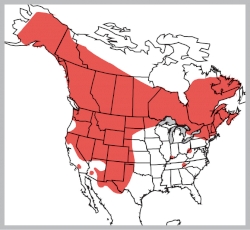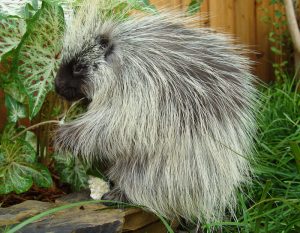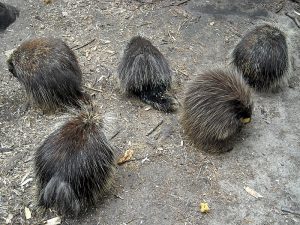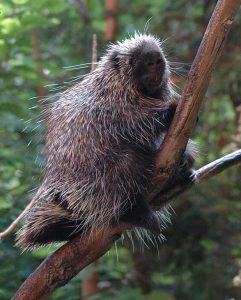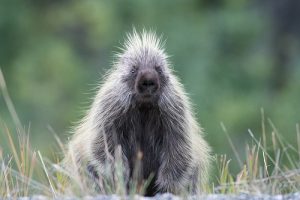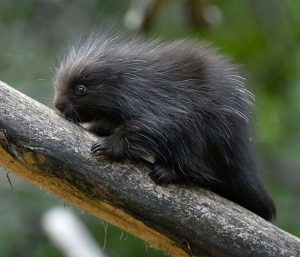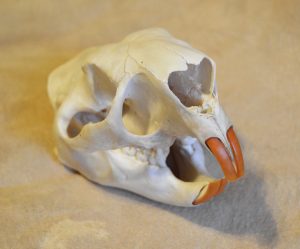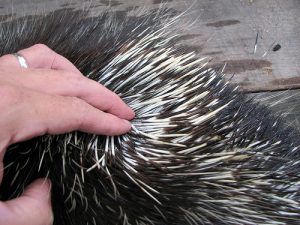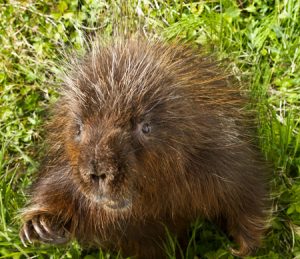North American Porcupine
The North American porcupine is the second largest rodent species found in North America. It is an herbivorous animal with pines, or quills, as they are called, all across their body, except the face, underbelly and limbs.
Scientific Classification
| Kingdom | Animalia |
| Phylum | Chordata |
| Class | Mammalia |
| Order | Rodentia |
| Family | Erethizontidae |
| Subfamily | Erethizontinae |
| Genus | Erethizon |
| Scientific Name | Erethizon dorsatum |
Quick Information
| Other names | Common porcupine, Canadian porcupine |
| Size | Head-to-tail length: 75-120 centimeters (2.6 to 4 feet) Tail length: up to 30 centimeters (1 foot) |
| Weight | Between 7.7 and 39.7 lbs; average is around 20 lbs |
| Color | Dark brown to black; quills on the back are sometimes yellow or white |
| Distribution | Most of Alaska and Canada, north of the Great Lakes; West and Northeast of the United States; also found in Mexico |
| Habitat | Coniferous, deciduous and mixed forests; open tundra and desert chaparrals |
| Vocalization | During mating season, females communicate through high-pitched sounds; a threatened porcupine may chatter its teeth to ward off any looming threats; males use fierce noises while competing during mating season |
| Lifespan | 5 to 7 years |
| Diet | Summer diet includes twigs, roots, berries and other vegetation; during winter season, they rely on conifer needles and barks of trees for their main source of food |
| Adaptation | Since they lack canine teeth, it becomes easier for them to chew their food more efficiently by drawing their lips inward while nibbling on the food; specialized arrangement of jaw muscles also helps them in this regard; the quills on their body are used by them as a defense mechanism against potential threats and predators |
| Gestation Period | Around 7 months |
| Number Of Offspring | 1 |
| Predators/Enemies | Wolverines, coyotes, wolves, mountain lions and bears; they are also hunted by the fisher cat, who have specialized themselves for hunting the quill-laden North American porcupine |
| IUCN Conservation Status | Least Concern |
Behavior
Mainly a nocturnal creature, the common porcupine is near-sighted and sluggish in its movements. During the summer, it frequently rests in trees. When winter comes, it often stays and sleeps near its den, though it does not hibernate. Its defense mechanisms grant it the possibility to lead a solitary life.
Mating and Reproduction
The females lead a solitary life except during the period between late summer and early fall. Male porcupines often fight with each other over females. The winner dances elaborately around the female before spraying her with urine. Although they are polygamous, a male will stick around for a couple of days after mating to defend his partner; this is done to make sure that no other males can mate with her during this period.
Life Cycle
The newborn is given birth about seven months after mating; it is born with soft quills that gradually harden up a few hours after birth. It stays with its mother for about six months before moving onto a solitary life.
Interesting Facts
- The quills are not the North American porcupine’s only defense; when agitated, they often increase the strength of a stench that warns off predators.
- Since the common porcupines have a tendency of falling to the ground from fragile tree branches, they are often protruded by their own quills. To counter this, they have an inbuilt antibiotic supply in their skin to aid them in their recovery.
- The North American porcupine is one of the few animals that has black and white coloring on its body; it can afford this because, in most cases, it wants its potential predators to know that it is nearby and therefore, to keep safe distance. Skunks and wolverines are the only other animals to have this color combination on their bodies.
References:
- https://en.wikipedia.org/wiki/North_American_porcupine
- http://www.nhptv.org/natureworks/porcupine.htm
- https://www.nationalgeographic.com/animals/mammals/facts/porcupines
- http://animaldiversity.org/accounts/Erethizon_dorsatum/
Published on July 14th 2016 by Sudipto Chakrabarti under Coniferous Forest Animals.
Article was last reviewed on 5th December 2024.


